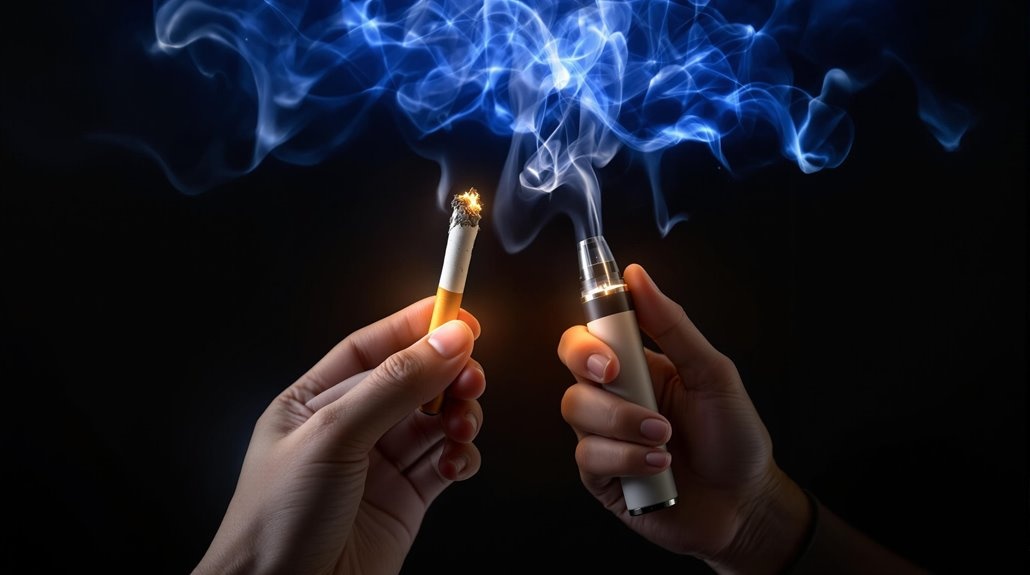Breaking Bad Habits: the Psychology of Switching From Smoking to Vaping
- Posted on
- 0

Making the switch from smoking to vaping means dealing with both your body's need for nicotine and the way your mind works. There are two main things to tackle: the physical craving for nicotine and the everyday habits that make you want to smoke. Your brain has learned to link certain times and places with smoking, making you want a cigarette when you're in those spots. When you start vaping, you can still get nicotine while breaking these old patterns. To succeed, you need to spot what makes you reach for a cigarette, find new ways to handle stress, and slowly cut back on nicotine. Research shows there are several ways that work well to help you make this important change.
Key Takeaways
-
Pod mod systems help manage nicotine cravings while maintaining familiar hand-to-mouth motions during the transition from cigarettes.
-
Vaping provides control over nicotine levels, allowing gradual reduction while minimizing withdrawal symptoms.
-
Environmental triggers linked to smoking can be redirected to vaping, making behavioral change more manageable.
-
Joining vaping communities offers support and shared strategies for breaking deep-rooted smoking habits.
-
Replacing smoking rituals with vaping helps maintain reward pathways while reducing harm from traditional cigarettes.
Understanding Nicotine Addiction Mechanisms
Nicotine addiction works in powerful ways that help explain why smokers find it hard to stop and why some turn to vaping instead. When nicotine enters your body, your brain releases feel-good chemicals that create strong habits that become part of how you think and feel. These brain connections grow stronger as time passes, making it harder to break free from nicotine's hold.
As your brain gets used to nicotine, it needs more to feel normal, and you feel sick when you try to quit. What makes stopping extra hard is that addiction works in two ways - it's not just about what nicotine does to your body. Things around you, like seeing others smoke or feeling stressed, can make you crave nicotine badly, even long after the body stops needing it. That's why beating nicotine means dealing with both the body's needs and the mind's habits. Studies show that success rates increase significantly when smokers transition to vaping, with 60-74% of people successfully quitting traditional cigarettes.
Environmental Triggers and Classical Conditioning
Every regular smoker's brain creates strong links between everyday situations and smoking. This happens naturally over time, much like a dog learning to expect food when it hears a dinner bell.
Your surroundings play a big part in why quitting feels so hard. Things like seeing someone light up or walking past your usual smoking spot can trigger sudden urges to smoke. This isn't just a random urge - your brain has learned to connect these moments with the good feelings that smoking gives you.
To quit successfully, you need to spot these triggers and find new ways to handle them. Once you know how your everyday world pushes you toward smoking, you can start breaking these deep-rooted patterns that keep you hooked.
Many people find that pod mod systems provide a smoother transition from cigarettes to vaping, helping them better manage their environmental triggers.
Reward Systems in Smoking
Your brain has a strong reward setup that makes smoking hard to stop. When you smoke, nicotine sets off a feel-good brain chemical called dopamine, making you feel pleased. This isn't just a bad habit - it's your brain's deep-rooted system at work.
Your brain gets used to nicotine and wants it more and more.
Every cigarette makes these brain connections stronger.
When you stop smoking, your brain feels bad and pushes you to smoke again.
To quit, you need to build new habits that help your brain learn different rewards.
When you know how this works, you can better understand why switching to healthier choices takes time and steady work to change your brain's reward system.
Many people transition to vaping since it delivers nicotine levels ranging from zero to 36mg/mL, allowing careful control of intake.
Breaking Behavioral Patterns
Breaking the smoking habit comes down to three main parts: what makes you start, what you do next, and what makes you feel good after. Studies show that to quit smoking, you first need to spot what sets you off - things like feeling stressed, having trouble focusing, or a racing heart.
To break these habits, you can switch to vaping since it feels like smoking but without burning tobacco. The time it takes is different for everyone, and talking to a counselor can help make the switch easier. Make changes at home and work by getting rid of things that remind you of smoking, and spend time with people who support your choice to quit.
When you practice new habits over and over, your brain learns to enjoy them more, which helps make vaping feel more natural. While vaping is not officially recognized as a smoking cessation tool, it may be less harmful than traditional cigarettes for adult smokers seeking alternatives.
Building New Coping Strategies
Building better ways to cope means finding new habits to handle daily stress when you switch from cigarettes to vaping. To stop smoking, you need good ways to deal with urges and build better habits. While vaping helps by giving you nicotine, you still need other ways to handle stress for the best results.
Use calming methods like slow breathing and staying focused on the present. Get help from friends and family who care about your progress. Know what makes you want to smoke and stay away from those things. Find new things to put in your mouth, like sugar-free mints.
These steps will help you stay strong as you move away from both vaping and smoking.
Consider joining local vaping communities to connect with others who can share coping strategies and support your journey.
Creating Lasting Change
Breaking free from smoking through vaping takes knowing how your brain works with rewards. Many people in the US find it tough to quit nicotine, so you need to change what makes you feel good step by step.
Lower your vaping nicotine bit by bit while learning new ways to handle stress. Talk to others who quit smoking - you can find help through online mental health sites that offer free support. Keep track of how you're doing and share your wins with people who care. Don't worry if you slip up - it's normal and helps make you stronger.
Frequently Asked Questions
What Happens to Your Body When You Switch From Smoking to Vaping?
Your body starts working better when you switch from cigarettes to vaping. Your lungs get stronger, you can breathe easier, and your heart gets healthier. You're less likely to get sick with heart problems or cancer, and your blood pressure drops to safer levels. These good changes happen over the first few months after you make the switch.
How Do You Transition From Smoking to Vaping?
Pick a vape that feels right for you, try different flavors until you find ones you like, and slowly cut back on nicotine over time. Deal with cravings by leaning on friends and family, and stick to a clear plan that helps you stop mixing smoking with vaping.
What Habits Can Replace Vaping?
Try these instead of vaping: pop in some gum, sip water often, get moving with sports or walks, head outside for fresh air, take quiet moments to breathe deeply, or grab a good book. These keep your hands busy and your mind focused on better things.
Which Is Worse, Vaping or Smoking?
Smoking does more damage than vaping, since we know it kills people and harms others who breathe the smoke. But don't be fooled - vaping can still hook you and hurt your lungs badly.
Conclusion
You've now gained key insights into the psychological mechanisms behind migrating from smoking to vaping. By understanding your nicotine addiction pathways, identifying personal triggers, and implementing evidence-based behavioral modifications, you're better equipped to make this change. While the journey isn't simple, your awareness of reward systems and development of new coping strategies will support your successful shift to healthier alternatives. At K Town Vapour Lounge, we're here to support your transition with expert guidance and quality vaping products.


Comments
Be the first to comment...